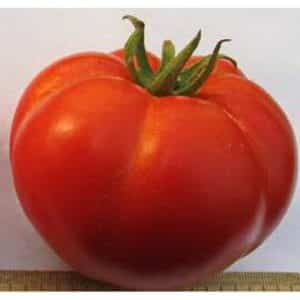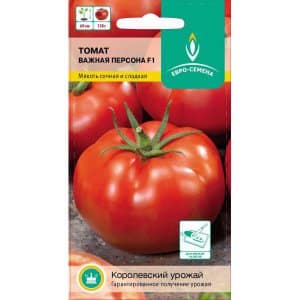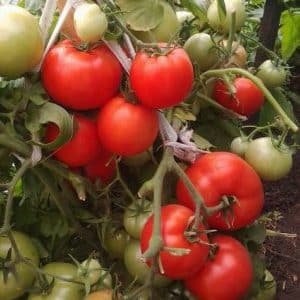The guest of honor at your country plot is the “Important Person” tomato and its advantages over other varieties
The Big Person tomato was created by domestic breeders. Scientists have managed to develop a crop that grows equally well under prolonged drought and at low temperatures. Important person refers to hybrids that grow in open ground. It was added to the state register for two districts of the Russian Federation: East Siberian and Far Eastern.
Growing such a tomato is easy and simple. It is enough to find out what features it has, how to properly care for seedlings and what difficulties may arise for beginning farmers.
Description
Important person - early ripening, determinant, low-growing hybrid f1. Designed for cultivation in open ground, home and industrial greenhouses.
Appearance of the hybrid

The bush is compact, does not require pinching, reaches a height of 35-110 cm in open soil and 1.5 m in a greenhouse. The leaf blade is green, medium in size. The inflorescence is simple. The tomato forms 3-4 simple leaves while growing in open ground.
One cluster produces from 5 to 8 fruits.
Distinctive features
An important person has the following features:
- resistance to drought, high humidity;
- suitable for long-term transportation without loss of presentation;
- the growing season is 95-100 days;
- resistant to late blight, alternaria, tobacco mosaic, root and crown rot, fusarium, bacterial spot;
- universal - tomatoes are added to salads, pickles, marinades.
Important! An important person is valued not only for its ease of care, but also for its excellent taste. Even a damp and cool summer cannot harm the fruits and deprive them of their juiciness and fleshiness.
Fruit characteristics, yield
The hybrid boasts:
- fruits are flat-round in shape, slightly ribbed at the base;
- rich red color;
- resistance to cracking - the peel is dense, matte, pleasant to the touch;
- sweet and moderately dense pulp;
- good yield.
One ripe fruit can weigh 130-160 g. From 1 sq. m of plot, 26 kg of ripe fruits are collected, and from 1 bush - 3-3.5 kg. But there have been cases when some specimens in greenhouses reached a weight of 200-250 g.
How to grow seedlings
According to the producers of Big Person, tomatoes have strong immunity to the main nightshade diseases. In addition, hybrid seeds are treated at the production stage. But some gardeners advise playing it safe and disinfecting the seed.
Seed preparation

There are 4 ways to disinfect and stimulate growth - choose any:
- Dilute 1 g of potassium permanganate in 100 ml of water. Soak gauze in the solution and place the seeds in it. Keep it like this for 20 minutes. Then rinse and dry slightly.
- Dissolve 0.5 g of soda in 100 ml of water. Soak the seed in the solution for 1 day.
- Mix 1 tbsp. l. aloe juice and 1 tbsp. l. water. Soak the seeds for 15 hours. The solution will increase immunity, productivity and quality of plants.
- Dilute 1 drop of Fitosporin in 100 ml of water. Keep the seeds in the mixture for about 2 hours.
Attention! Whether or not to soak seeds is a personal decision for the gardener.Professionals recommend not paying attention to the ideal characteristics of varieties and hybrids, but following a clear plan.
Additionally, it is worth checking the planting material for defects. Dissolve 1 tbsp. l. salt in a glass of water. Dip the seeds into the solution. “Empty” ones will float to the surface - such material is removed.
Container and soil
You can choose any container as a “temporary house” for future seedlings. The soil is bought in a special store: universal soil contains all the minerals and vitamins necessary for tomatoes. However, before sowing seeds, it is better to disinfect the soil: infectious agents and pest larvae may persist in it.
Several methods of soil treatment:
- bake in the oven at a temperature of 180-240 °C for 20 minutes;
- heat in the microwave for 1-2 minutes;
- pour boiling water over the soil;
- soak in 1% solution of potassium permanganate.
Reference. The soil is prepared 20-25 days before sowing the seeds. During this time, the pathogens will die and the soil will become safe for further use.
Sowing
The seeds are immersed in a container with soil at the end of March. First, the soil is moistened, then planting material is placed on its surface. Sprinkle 1 cm of soil layer on top and spray with water from a spray bottle.
Growing and care
The containers can be placed on the windowsill so that the seeds receive enough light. The soil is moistened as it dries, preventing the formation of a dry crust. After the first shoots appear, the seedlings are hardened off. Do not water the plants before the procedure.
Hardening modes: during the day - 16-20 °C, at night - 8-10 °C. It is better to harden it this way: open a window or window every day for 1-2 hours, and in calm weather take the containers out onto the balcony.
After the formation of the first 2-4 true leaves, the plants are planted in separate containers.
How to grow tomatoes
The important person is an easy-to-care hybrid. However, experienced farmers recommend timely care for plants.
Landing
The seedlings are ready for planting 2 months after sowing the seeds. The following instructions will help you plant plants correctly:
- Prepare the area. Dig a shallow trench along the bed - about 30 cm. Form 5-6 holes in the trench, at a distance of 40 cm from each other. The passage between the “ribbons” is 80 cm.
- Fertilize the holes. 24 hours before planting the tomatoes, add 1 glass of a weak solution of manganese and the same amount of yeast mixture to each hole (dilute 10 g of yeast in 10 liters of water and let it brew for 24 hours). Then pour in 100 g of eggshells and wood ash.
- Plant plants. Place each bush in its own hole so that the stem goes 2 cm deep into the ground. Sprinkle soil on top, mulch and water well.
Important! If the seedlings have grown too early, you can slightly delay the fruiting period. It is enough to remove the first flowering branch, but with extreme caution. The second such branch will appear in 7 days, and the tomato can already be planted in open ground.
Care
Procedure for caring for tomatoes:
- Watering. Drip irrigation is optimal for tomatoes. Such systems are sold in specialized stores. The equipment is worth using if you grow tomatoes for industrial purposes. For an ordinary gardener, it is enough to pour one bucket of water under each bush, being careful not to wet the leaves and skin of the fruit. It is recommended to water the plants as the soil dries out.
- Weeding. Weeds are removed as they appear.This will prevent the appearance of pests on the site.
- Loosening. The soil is loosened in the daytime to a depth of 5-7 cm to improve root aeration.
- Bush molding. Remove dry, yellow leaves from the bush. If the plant has become too wide, carefully remove the branches (but not the inflorescences).
- Garter. Place supports near the tomatoes to prevent the plants from breaking (especially when the fruits are ripening).
- Mulching. Cover the soil with dark material to prevent infectious diseases from affecting the tomatoes.
Without fertilizing it is impossible to get a rich and tasty harvest. Here are some recommendations:
- The first fertilizing is applied 2-3 weeks after planting. Manure is diluted with water in a bucket in a ratio of 1:5. Then the mixture is infused for a couple of weeks, again diluted with water 1:2. Apply 1-2 liters of liquid under each bush.
- Second fertilizing is applied during the flowering period. Manure is prepared according to the previous principle. Additionally, dilute 1 drop of iodine and 2 tbsp in 1 liter of warm water. l. whey. The leaves are sprayed with this mixture.
- The third feeding is necessary during fruit formation. Manure can be replaced with chicken droppings, but this solution must be infused for 10 days.
Important! You can feed tomatoes with complex fertilizers. They are sold in special stores. Follow the manufacturer's recommendations.
Features of cultivation and possible difficulties
Growing tall Bigwig is no different from growing other varieties. But the hybrid requires a lot of space for normal development: approximately 1 sq. m for 3 plants. After the stems get stronger and stretch out, they need to be tied to a trellis.
Difficulties may arise when watering.Excess moisture can cause excessive leaf growth (this inhibits fruit development). Insufficient watering leads to loss of ovaries (they crumble). A beginner should carefully monitor soil moisture.
Reference. Difficulties with watering can be solved with mulch. It will retain moisture and prevent an increase in air humidity. Mulch can be in the form of grass clippings or straw. Additionally, it will protect plants from late blight.
Diseases and pests
The most dangerous diseases: late blight, brown spot, mosaic, gray and brown rot, black leg. To prevent the occurrence of diseases, it is enough to disinfect planting material, water moderately, and observe crop rotation.
Pests: mole crickets, click beetle larvae, aphids, cutworms, whiteflies. The drug "Phosbecid" will help control insects. Dilute 10 ml of the product in 10 liters of water and spray the plants with the solution. Two treatments will be required with an interval of 15-20 days.
The nuances of growing in open ground and in a greenhouse
It is important to protect tomatoes from direct sunlight. For outdoor cultivation, it is better to choose a slightly shaded area. When using glass greenhouses, whitewash the roof and side surfaces.
It is necessary to regularly inspect plants for the appearance of pests and diseases - insects reproduce most actively in greenhouse conditions.
Harvesting and application
When the tomatoes turn a bright red color, it is time to harvest.
The hybrid is universal in use - suitable for salads, main courses, and winter preparations. Juice, lecho, and other canned food for the winter are prepared from the fruits.
Advantages and disadvantages of the variety
The advantages of an Important Person are high productivity, ease of care, resistance to adverse weather conditions and diseases, delicious taste and attractive appearance.
There is only one drawback - it requires a lot of space to grow. But such a minus is hardly noticeable against the background of many advantages.
Farmer reviews
Reviews from gardeners about the results of growing VIP are mostly positive.
Lyudmila, 40 years old, Omsk: “An important person deserves a solid A.” The description on the package with seeds and the photo corresponds to the result obtained.”
Elizaveta, 38 years old, Krasnodar: “The tomatoes didn’t get sick during the season, although I still treated the seeds just in case. It’s convenient that you don’t have to stepchild.”
Anna, 53 years old, Ufa: “We had to devote the entire greenhouse to tomatoes. The harvest is not bad, but next year I’d rather plant several different varieties in the same area.”
Conclusion
The Important Person tomato is an interesting hybrid that pleases the vegetable grower with a tasty and rich harvest. But good results can only be achieved through hard work.
The main thing is not to forget to disinfect planting material and soil, feed and water the plants in a timely manner, protect them from the sun and pests, and follow general recommendations from experienced farmers.